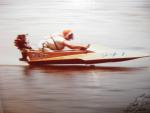Boy, is there a lot to learn about props!
I've built 3 of them so far, using stainless blades 'removed' from factory props and welded to a custom made hub. In each I tried different shapes and pitches, using a cobbled up pitch block and measuring them with a homemade rake and pitch measuring deal.
The results have been---ah---educational. My latest prop (in the photo) after three tweeks, is now holding the motor down to 5,800 rpms (where I want it), but the boat is slower than with another prop I made that holds the motor down to 5,300 rpms. (My respect for Ron Hill and others who know what they're doing grows daily!)
This latest prop, after tweeking, has a pitch of 10 " initially, going to 12 " at the mid point, to 20 " at the aft end (not counting cupping). Obviously, that is not what I intended, and with so much progressive pitch it's really inefficient (hence the lousy top speed).
Getting to my question (at last), I've measured progressive increasing pitch on several factory props (of about an inch total), and noticed that cleavers seem to have a negative (reducing) pitch. I was wondering what the thinking is on this subject, and the theory behind it.
Can anyone explain the progressive pitch concept?
Thanks,
Jeff


 Thanks:
Thanks:  Likes:
Likes: 


 Reply With Quote
Reply With Quote

Bookmarks